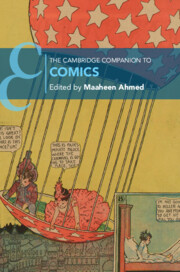Book contents
- The Cambridge Companion to Comics
- The Cambridge Companion to Comics
- Copyright page
- Contents
- Figures
- Contributors
- Acknowledgments
- Chronology
- Introduction
- Part I Forms
- Chapter 1 Comics Drawing
- Chapter 2 Comics, Media Culture, and Seriality
- Chapter 3 Comics and Graphic Novels
- Chapter 4 Manga
- Chapter 5 Digital Comics
- Part II Readings
- Part III Uses
- Further Reading
- Index
- Cambridge Companions To …
- References
Chapter 5 - Digital Comics
An Old/New Form
from Part I - Forms
Published online by Cambridge University Press: 17 August 2023
- The Cambridge Companion to Comics
- The Cambridge Companion to Comics
- Copyright page
- Contents
- Figures
- Contributors
- Acknowledgments
- Chronology
- Introduction
- Part I Forms
- Chapter 1 Comics Drawing
- Chapter 2 Comics, Media Culture, and Seriality
- Chapter 3 Comics and Graphic Novels
- Chapter 4 Manga
- Chapter 5 Digital Comics
- Part II Readings
- Part III Uses
- Further Reading
- Index
- Cambridge Companions To …
- References
Summary
This chapter provides an overview of the variety of contemporary digital comics.
Digital comics encompass diverse objects, both online and offline, ranging from print comics that are digitized to webcomics that resist print publications and have greater affinities with video games or animation. The chapter regroups these different formats into three main categories; it reconstructs the history of digital comics, isolating four partially overlapping phases connected to the evolution of digital culture. It traces the similarities and divergences between digital and print comics, identifying their formal specificities and contextualizing them in the analog/digital debate; and discusses their different characteristics in terms of immersion and agency. Finally, it reflects on the relationship between digital media and participatory practices on the one hand, and comics preservation on the other, elaborating on the issue of copyright infringement.
In doing so, the chapter offers a multidisciplinary and comprehensive account of the heterogeneous nature and stratified history of digital comics.
Keywords
- Type
- Chapter
- Information
- The Cambridge Companion to Comics , pp. 102 - 122Publisher: Cambridge University PressPrint publication year: 2023
References
Primary Sources
Secondary Sources
- 1
- Cited by

